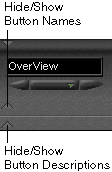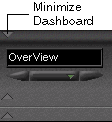Cosmo Player 2.1 Quick Reference
Copyright © 1997, 1998 Silicon Graphics, Inc. - All Rights Reserved
Cosmo Player plugs in to your Web browser to enable you to see and explore 3D worlds.
With Cosmo Player you can visit any 3D world authored in the Virtual Reality Modeling
Language (VRML). These 3D worlds often include other kinds of multimedia, like sound and
movies.
This quick reference gives brief descriptions of each of the elements in the Cosmo
Player interface.
Basic navigation is covered in Getting Started
with Cosmo Player 2.1.
You can find more in-depth information--including a table of keyboard equivalents for
Cosmo Player buttons--in Going Further with
Cosmo Player 2.1.
You can find more technical information about installation and trouble-shooting in the Release Notes.
On the Dashboard
You use the main controls on the Cosmo Player dashboard to do two things: move around
in 3D worlds and examine objects in 3D worlds. (Some worlds don't display the dashboard,
but they may provide on-screen cues to navigation.)
If your dashboard looks like this, you're using the Movement controls:

If your dashboard looks like this, you're using the Examine controls:

Some worlds allow you to use only Movement controls (Go, Slide, Tilt,
Float, and Gravity). Other worlds allow you to use only Examine
controls (Rotate, Pan, and Zoom). Still other worlds
allow you to use both Movement and Examine controls. Even if both sets of controls are
available to you, it's usually best to use the controls that are displayed when you first
enter a world. You could easily become disoriented by switching randomly from one set
of controls to another!
Click the Change Controls button to switch between Movement and
Examine controls. Or press ` (backquote), ~
(tilde), or - (minus key on numeric keypad).

For detailed information, see "Movement Controls,"
"Examine Controls," and "Common
Controls."
A Word About Control Buttons . . .
An unselected button is gray-green. A selected button is bright
green. Unavailable buttons are flat and gray.

See "Movement Controls," "Examine
Controls," and "Common Controls."
When you pass the pointer over a button, the button's name and description
are displayed. See "Hide/Show Button Names" and
"Hide/Show Button Descriptions."

Resizing the Dashboard
You can minimize and re-expand the display of the dashboard. Minimizing the dashboard
does not change its functions or disable navigation. When the dashboard is minimized, you
can still click and drag to navigate. You can also use keyboard equivalents for Cosmo
Player buttons.
To minimize the dashboard, click the small triangle in the upper-left corner.

To expand the dashboard, click the small triangle in the bottom-left corner of
the minimized dashboard.
Using Mouse and Keyboard
You can navigate with the mouse, the keyboard, or both mouse and keyboard.
To navigate with the mouse, choose a control and drag in the window. There are several
ways of doing this:
- Click a control, release the mouse button, and then click-and-drag in the window.
When you release the mouse, the control remains "permanently" selected until you
click another.
- Click a control, hold down the mouse button, and drag in the window.
This method temporarily selects a control: when you release the mouse button, selection
reverts to the last button "permanently" selected.
- Hold down Ctrl or Alt to temporarily select a control.
When you release Ctrl or Alt, selection reverts to the
last button "permanently" selected.
To navigate with the keyboard, choose a control and press the arrow keys (singly or in
combination).
Most controls have keyboard equivalents.
See "Movement Controls," "Examine
Controls," and "Common Controls." For
information on optimizing the keyboard commands for left-handed or right-handed use, see Going Further with Cosmo Player 2.1.
Movement Controls
You use Movement controls to move around in a 3D world.
See also "Using Mouse and Keyboard," "Examine Controls," and "Common
Controls."

- Go

- Go is the default Movement control. Click Go and then
drag the pointer in the scene window to move in the world. Drag up to go forward, drag
down to go backward, drag left to turn left, and drag right to turn right. Go
turns your view in the direction of travel. Hold down Shift to go faster.
- Slide

- Click Slide and then drag to slide straight up or down, or to slide
right or left. Slide does not turn your view in the direction of travel.
Press Alt to temporarily select Slide when you're using Go
or Tilt. Hold down Shift to slide faster.
- Tilt

- Click Tilt and then drag to look up and down or from side to side
without moving. Press Ctrl to temporarily select Tilt
when you're using Go or Slide.
- Gravity

- Click Gravity to turn gravity on. This keeps you on the ground or floor
as you navigate through a world. Keyboard equivalent: Tab or +
(plus sign on numeric keypad).
- Float

- Click Float to turn gravity off. This enables you to navigate off the
ground or floor of a world. Keyboard equivalent: Tab or +
(plus sign on numeric keypad).
Note: The author of the 3D world determines whether the Float
and Gravity buttons are enabled.
Examine Controls
You use Examine controls to examine objects within a 3D world.
Note: You should not use Examine controls in a world
that has a "floor" and "ceiling" or "ground" and
"sky": if you do so, you can very easily get disoriented.
See also "Using Mouse and Keyboard," "Movement Controls," and "Common
Controls."

- Rotate

- Rotate is the default Examine control. Click Rotate
and then drag to spin an object in front of you. You can also use the arrow keys (singly
or in combination). Rotate faster by holding down an arrow key and Shift.
- Pan

- Click Pan and then drag to pan up, down, left, or right. You can also
use the arrow keys (singly or in combination). Pan faster by holding down an arrow key and
Shift. Press Alt to temporarily select Pan
when you're using Rotate or Zoom.
- Zoom

- Click Zoom and then drag up to zoom in or drag down to zoom out. You
can also use the arrow keys (singly or in combination). Zoom faster by holding down an
arrow key and Shift. Press Ctrl to temporarily select Zoom
when you're using Rotate or Pan.
Common Controls
Movement and Examine controls are supplemented by a range of common controls that
normally appear on the left and right sides of the dashboard. (Remember that the author of
a world can decide which controls are available to you.) See also"Using Mouse and Keyboard," "Movement
Controls," and "Examine Controls."

- Seek
- Click Seek and then click an object in the Cosmo Player window to go
directly to it.
- Continuous Seek
- Double-click Seek to enter Continuous Seek mode, which
makes your pointer act as if Seek were being continuously pressed. The Seek
button turns white. In Continuous Seek, other navigation controls
continue to function, but you don't interact with active objects. You can program a mouse
button for Continuous Seek; see Going Further with Cosmo Player 2.1.
- Straighten
- Click to place your view upright and level in the world. Keyboard equivalent: End.
- Undo Move
- Click to move back to the last place you stopped. Keyboard equivalent: Delete
or Backspace.
- Redo Move
- Click to move back to where you were before you clicked Undo Move. Keyboard
equivalent: Insert or Shift+Backspace.
- Current Viewpoint
- Click to return to the current viewpoint.
- Viewpoint List
- Click to display a list of interesting places in the world.
- Previous Viewpoint
- Click to go to the previous viewpoint in the Viewpoint list. Keyboard
equivalent: Page Up.
- Next Viewpoint
- Click to go to the next viewpoint in the Viewpoint list. Keyboard
equivalent: Page Down.
- Hide/Show Button Names
- Click to hide or show button names and descriptions when you pass the pointer over a
button.
- Hide/Show Button Descriptions
- Click to hide or show button descriptions when you pass the pointer over a button..
- Change Controls
- Click to change from Movement controls to Examine controls or vice-versa. Keyboard
equivalent: ` (backquote), ~ (tilde), or -
(minus key on numeric keypad).
- Help
- Click to display on-line documentation.
- Preferences
- Click to display the Preferences window, where you set options for
Cosmo Player behavior, including optimizing keyboard equivalents for left-handed or
right-handed use. See Going Further with
Cosmo Player 2.1.
- Cosmo Software home page
- Click to display the Cosmo Software home page in your Web browser.
Cosmo Player Support
Cosmo Player support is currently available in English only on the Cosmo Software site
at http://cosmosoftware.com or for
a per incident charge through our call center at 1-888-91-COSMO. Cosmo Support Services
call center provides support from 9 a.m.-5 p.m. MST.
Part number 007-3853-001 / Revised April 2, 1998

















